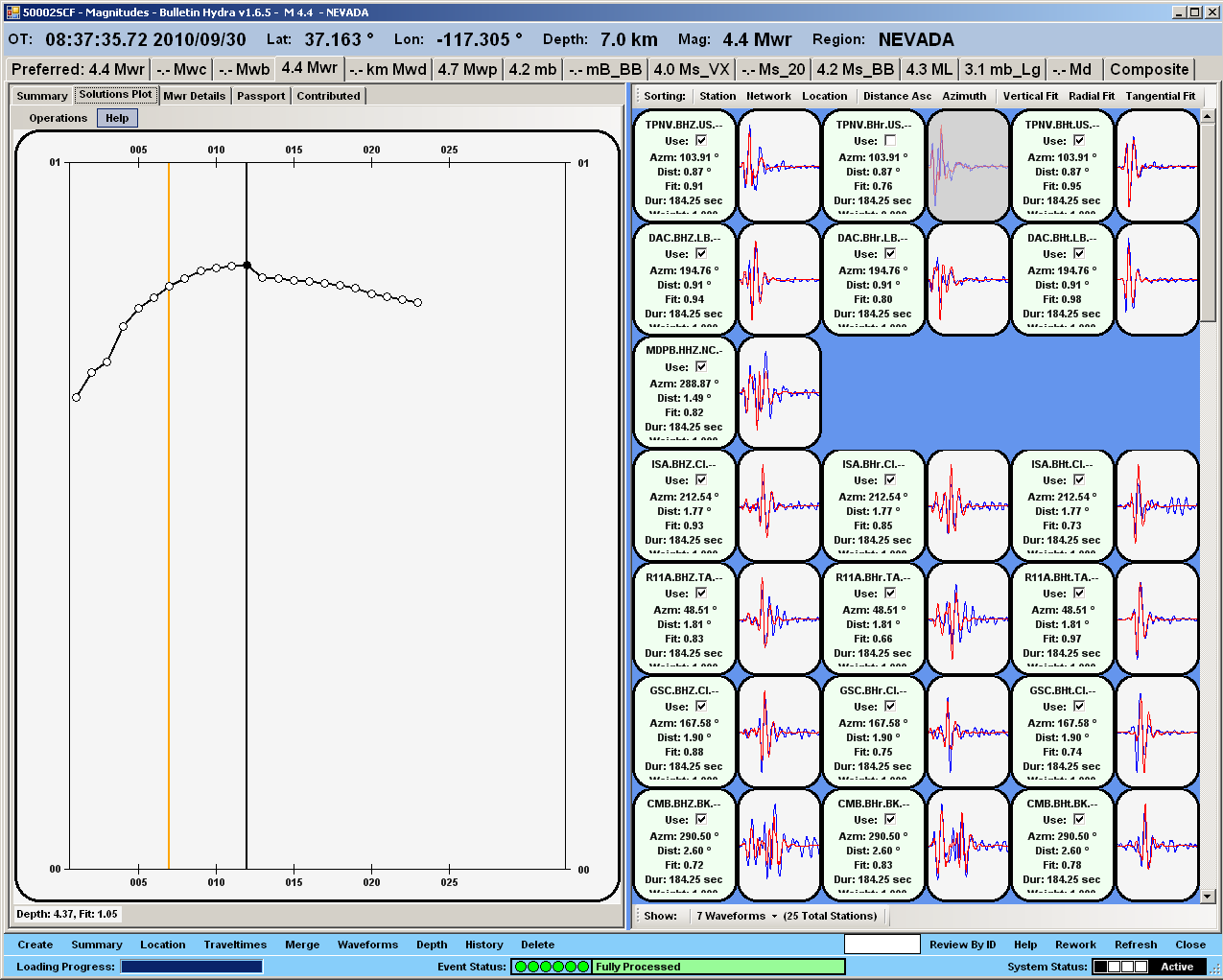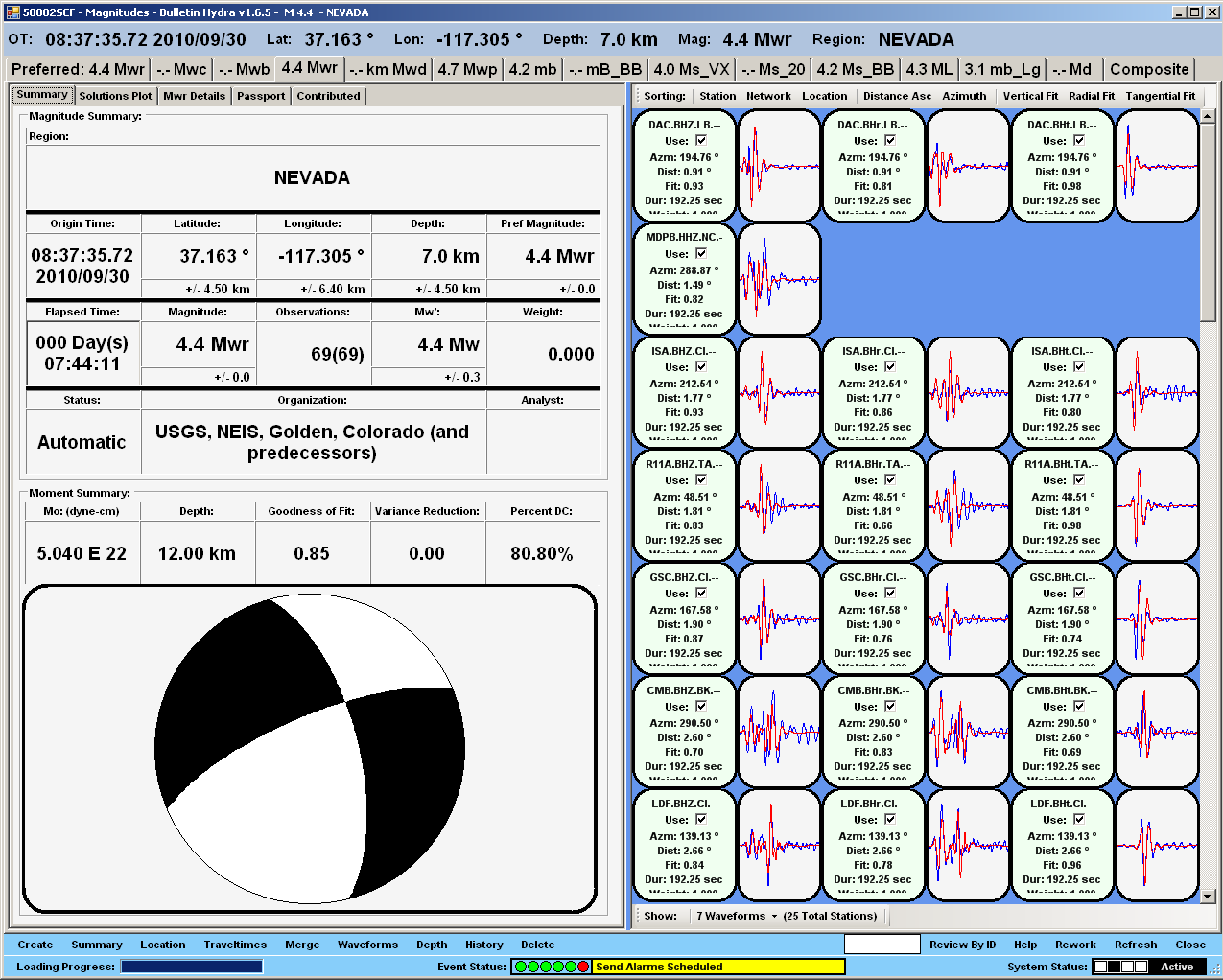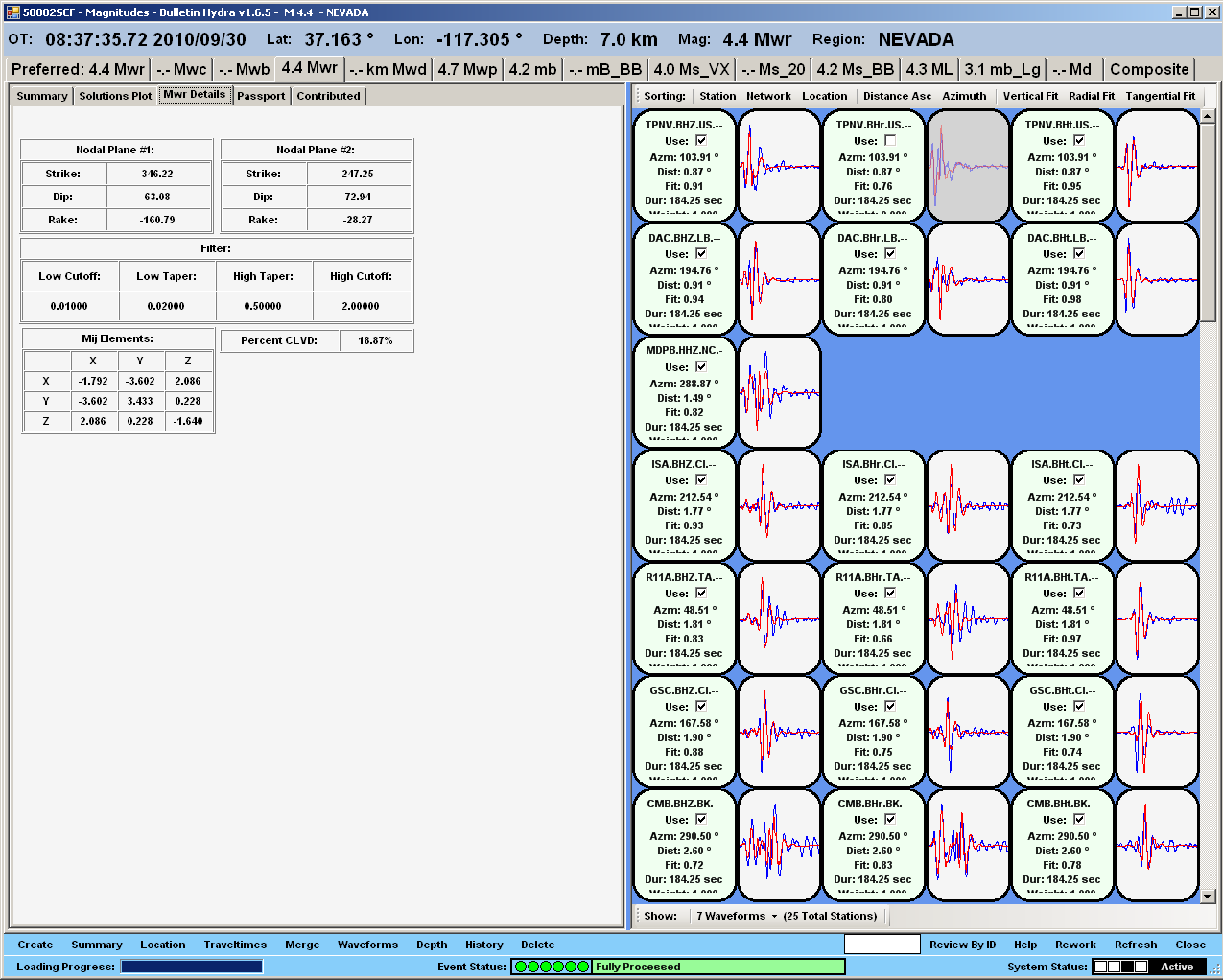Location
Location ANSS
The ANSS event ID is nn00429638 and the event page is at
https://earthquake.usgs.gov/earthquakes/eventpage/nn00429638/executive.
2010/09/30 08:37:36 37.140 -117.380 6.5 4.3 Nevada
Focal Mechanism
USGS/SLU Moment Tensor Solution
ENS 2010/09/30 08:37:36:0 37.14 -117.38 6.5 4.3 Nevada
Stations used:
BK.CMB BK.MOD CI.BAR CI.GLA CI.GSC CI.ISA CI.LDF CI.MWC
CI.PASC II.PFO LB.BMN LB.DAC NC.MDPB US.DUG US.ELK US.TPNV
US.WUAZ US.WVOR UU.CCUT UU.CVRU UU.LCMT UU.MPU UU.MTPU
UU.NLU UU.PKCU UU.PSUT UU.SZCU UU.TCRU UU.TMU
Filtering commands used:
hp c 0.02 n 3
lp c 0.06 n 3
Best Fitting Double Couple
Mo = 4.84e+22 dyne-cm
Mw = 4.39
Z = 12 km
Plane Strike Dip Rake
NP1 250 75 -20
NP2 345 71 -164
Principal Axes:
Axis Value Plunge Azimuth
T 4.84e+22 3 298
N 0.00e+00 65 35
P -4.84e+22 25 207
Moment Tensor: (dyne-cm)
Component Value
Mxx -2.09e+22
Mxy -3.63e+22
Mxz 1.75e+22
Myy 2.92e+22
Myz 6.16e+21
Mzz -8.28e+21
##------------
########--------------
#############---------------
###############---------------
#################----------------
T ##################----------------
##################-----------------
#######################------###########
######################--################
##################-------#################
#############-------------################
##########----------------################
#######--------------------###############
###-----------------------##############
#-------------------------##############
-------------------------#############
-------------------------###########
-------- -------------##########
------ P ------------#########
----- ------------########
-----------------#####
------------##
Global CMT Convention Moment Tensor:
R T P
-8.28e+21 1.75e+22 -6.16e+21
1.75e+22 -2.09e+22 3.63e+22
-6.16e+21 3.63e+22 2.92e+22
Details of the solution is found at
http://www.eas.slu.edu/eqc/eqc_mt/MECH.NA/20100930083736/index.html
|
Preferred Solution
The preferred solution from an analysis of the surface-wave spectral amplitude radiation pattern, waveform inversion or first motion observations is
STK = 250
DIP = 75
RAKE = -20
MW = 4.39
HS = 12.0
The NDK file is 20100930083736.ndk
The waveform inversion is preferred.
Moment Tensor Comparison
The following compares this source inversion to those provided by others. The purpose is to look for major differences and also to note slight differences that might be inherent to the processing procedure. For completeness the USGS/SLU solution is repeated from above.
| SLU |
USGSMT |
UNR |
USGS/SLU Moment Tensor Solution
ENS 2010/09/30 08:37:36:0 37.14 -117.38 6.5 4.3 Nevada
Stations used:
BK.CMB BK.MOD CI.BAR CI.GLA CI.GSC CI.ISA CI.LDF CI.MWC
CI.PASC II.PFO LB.BMN LB.DAC NC.MDPB US.DUG US.ELK US.TPNV
US.WUAZ US.WVOR UU.CCUT UU.CVRU UU.LCMT UU.MPU UU.MTPU
UU.NLU UU.PKCU UU.PSUT UU.SZCU UU.TCRU UU.TMU
Filtering commands used:
hp c 0.02 n 3
lp c 0.06 n 3
Best Fitting Double Couple
Mo = 4.84e+22 dyne-cm
Mw = 4.39
Z = 12 km
Plane Strike Dip Rake
NP1 250 75 -20
NP2 345 71 -164
Principal Axes:
Axis Value Plunge Azimuth
T 4.84e+22 3 298
N 0.00e+00 65 35
P -4.84e+22 25 207
Moment Tensor: (dyne-cm)
Component Value
Mxx -2.09e+22
Mxy -3.63e+22
Mxz 1.75e+22
Myy 2.92e+22
Myz 6.16e+21
Mzz -8.28e+21
##------------
########--------------
#############---------------
###############---------------
#################----------------
T ##################----------------
##################-----------------
#######################------###########
######################--################
##################-------#################
#############-------------################
##########----------------################
#######--------------------###############
###-----------------------##############
#-------------------------##############
-------------------------#############
-------------------------###########
-------- -------------##########
------ P ------------#########
----- ------------########
-----------------#####
------------##
Global CMT Convention Moment Tensor:
R T P
-8.28e+21 1.75e+22 -6.16e+21
1.75e+22 -2.09e+22 3.63e+22
-6.16e+21 3.63e+22 2.92e+22
Details of the solution is found at
http://www.eas.slu.edu/eqc/eqc_mt/MECH.NA/20100930083736/index.html
|

|

|

|

|
REVIEWED BY NSL STAFF
Event ID:317359
Origin ID:755037
Seismic Moment Tensor Solution
2010/09/30 (273) 08:37:35.00 37.1385 -117.3803 755037
Depth = 14.0 (km)
Mw = 4.34
Mo = 3.98x10^22 (dyne x cm)
Percent Double Couple = 98 %
Percent CLVD = 2 %
no ISO calculated
Epsilon=-0.01
Percent Variance Reduction = 52.72 %
Total Fit = 15.42
Major Double Couple
strike dip rake
Nodal Plane 1: 342 82 179
Nodal Plane 2: 72 89 8
DEVIATORIC MOMENT TENSOR
Moment Tensor Elements: Spherical Coordinates
Mrr= -0.04 Mtt= -2.29 Mff= 2.32
Mrt= 0.48 Mrf= 0.21 Mtf= 3.20 EXP=22
Moment Tensor Elements: Cartesian Coordinates
-2.29 -3.20 0.48
-3.20 2.32 -0.21
0.48 -0.21 -0.04
Eigenvalues:
T-axis eigenvalue= 4.00
N-axis eigenvalue= -0.05
P-axis eigenvalue= -3.95
Eigenvalues and eigenvectors of the Major Double Couple:
T-axis ev= 4.00 trend=297 plunge=6
N-axis ev= 0.00 trend=77 plunge=82
P-axis ev=-4.00 trend=207 plunge=5
Maximum Azmuithal Gap=115 Distance to Nearest Station= 75.9 (km)
Number of Stations (D=Displacement/V=Velocity) Used=5 (defining only)
TIN.CI.D FUR.CI.D DAC.LB.D MLAC.CI.D
R11A.TA.D
###--------------
########-----------------
###########------------------
#############--------------------
###############--------------------
#################--------------------
T ###################---------------------
####################--------------------
######################-----------------####
#######################----------##########
########################---#################
############################################
############################################
#################-------####################
###########-------------###################
#####--------------------##################
------------------------#################
------------------------################
------------------------###############
-----------------------#############
----------------------###########
- ----------------#########
P -----------------######
---------------###
All Stations defining and nondefining:
Station.Net Def Distance Azi Bazi lo-f hi-f vmodel
(km) (deg) (deg) (Hz) (Hz)
TIN.CI (D) Y 75.9 263 82 0.020 0.080 TIN.CI.wus.glib
FUR.CI (D) Y 87.5 148 328 0.020 0.080 FUR.CI.wus.glib
DAC.LB (D) Y 97.2 191 11 0.020 0.080 DAC.LB.wus.glib
MLAC.CI (D) Y 140.0 293 113 0.020 0.080 MLAC.CI.wus.glib
R11A.TA (D) Y 207.0 49 230 0.020 0.080 R11A.TA.wus.glib
(V)-velocity (D)-Displacement
Author: www-data
Date: 2010/09/30 16:51:36
mtinv Version 2.1_DEVEL OCT2008
|

http://www.seismo.unr.edu/Events/main.php?evid=317359
|
Magnitudes
Given the availability of digital waveforms for determination of the moment tensor, this section documents the added processing leading to mLg, if appropriate to the region, and ML by application of the respective IASPEI formulae. As a research study, the linear distance term of the IASPEI formula
for ML is adjusted to remove a linear distance trend in residuals to give a regionally defined ML. The defined ML uses horizontal component recordings, but the same procedure is applied to the vertical components since there may be some interest in vertical component ground motions. Residual plots versus distance may indicate interesting features of ground motion scaling in some distance ranges. A residual plot of the regionalized magnitude is given as a function of distance and azimuth, since data sets may transcend different wave propagation provinces.
ML Magnitude

Left: ML computed using the IASPEI formula for Horizontal components. Center: ML residuals computed using a modified IASPEI formula that accounts for path specific attenuation; the values used for the trimmed mean are indicated. The ML relation used for each figure is given at the bottom of each plot.
Right: Residuals from new relation as a function of distance and azimuth.

Left: ML computed using the IASPEI formula for Vertical components (research). Center: ML residuals computed using a modified IASPEI formula that accounts for path specific attenuation; the values used for the trimmed mean are indicated. The ML relation used for each figure is given at the bottom of each plot.
Right: Residuals from new relation as a function of distance and azimuth.
Context
The left panel of the next figure presents the focal mechanism for this earthquake (red) in the context of other nearby events (blue) in the SLU Moment Tensor Catalog. The right panel shows the inferred direction of maximum compressive stress and the type of faulting (green is strike-slip, red is normal, blue is thrust; oblique is shown by a combination of colors). Thus context plot is useful for assessing the appropriateness of the moment tensor of this event.
Waveform Inversion using wvfgrd96
The focal mechanism was determined using broadband seismic waveforms. The location of the event (star) and the
stations used for (red) the waveform inversion are shown in the next figure.

|
|
Location of broadband stations used for waveform inversion
|
The program wvfgrd96 was used with good traces observed at short distance to determine the focal mechanism, depth and seismic moment. This technique requires a high quality signal and well determined velocity model for the Green's functions. To the extent that these are the quality data, this type of mechanism should be preferred over the radiation pattern technique which requires the separate step of defining the pressure and tension quadrants and the correct strike.
The observed and predicted traces are filtered using the following gsac commands:
hp c 0.02 n 3
lp c 0.06 n 3
The results of this grid search are as follow:
DEPTH STK DIP RAKE MW FIT
WVFGRD96 0.5 75 75 10 3.96 0.3007
WVFGRD96 1.0 255 80 10 3.99 0.3258
WVFGRD96 2.0 255 80 15 4.09 0.4019
WVFGRD96 3.0 80 55 20 4.19 0.4477
WVFGRD96 4.0 80 55 15 4.21 0.4851
WVFGRD96 5.0 75 60 5 4.23 0.5173
WVFGRD96 6.0 70 65 -10 4.26 0.5513
WVFGRD96 7.0 245 65 -30 4.30 0.5864
WVFGRD96 8.0 245 65 -35 4.34 0.6338
WVFGRD96 9.0 245 65 -30 4.36 0.6651
WVFGRD96 10.0 245 65 -30 4.37 0.6832
WVFGRD96 11.0 245 70 -25 4.39 0.6925
WVFGRD96 12.0 250 75 -20 4.39 0.6982
WVFGRD96 13.0 250 75 -20 4.40 0.6979
WVFGRD96 14.0 250 80 -20 4.41 0.6923
WVFGRD96 15.0 250 80 -20 4.41 0.6832
WVFGRD96 16.0 250 80 -15 4.42 0.6716
WVFGRD96 17.0 250 80 -15 4.43 0.6571
WVFGRD96 18.0 250 80 -15 4.43 0.6418
WVFGRD96 19.0 250 80 -15 4.43 0.6244
WVFGRD96 20.0 250 80 -15 4.44 0.6067
WVFGRD96 21.0 250 80 -15 4.44 0.5888
WVFGRD96 22.0 250 80 -15 4.45 0.5697
WVFGRD96 23.0 255 80 -15 4.43 0.5531
WVFGRD96 24.0 255 80 -15 4.44 0.5368
WVFGRD96 25.0 255 80 -15 4.44 0.5206
WVFGRD96 26.0 255 80 -15 4.44 0.5043
WVFGRD96 27.0 255 85 -15 4.45 0.4885
WVFGRD96 28.0 255 85 -15 4.45 0.4730
WVFGRD96 29.0 255 85 -15 4.45 0.4575
The best solution is
WVFGRD96 12.0 250 75 -20 4.39 0.6982
The mechanism corresponding to the best fit is

|
|
Figure 1. Waveform inversion focal mechanism
|
The best fit as a function of depth is given in the following figure:

|
|
Figure 2. Depth sensitivity for waveform mechanism
|
The comparison of the observed and predicted waveforms is given in the next figure. The red traces are the observed and the blue are the predicted.
Each observed-predicted component is plotted to the same scale and peak amplitudes are indicated by the numbers to the left of each trace. A pair of numbers is given in black at the right of each predicted traces. The upper number it the time shift required for maximum correlation between the observed and predicted traces. This time shift is required because the synthetics are not computed at exactly the same distance as the observed, the velocity model used in the predictions may not be perfect and the epicentral parameters may be be off.
A positive time shift indicates that the prediction is too fast and should be delayed to match the observed trace (shift to the right in this figure). A negative value indicates that the prediction is too slow. The lower number gives the percentage of variance reduction to characterize the individual goodness of fit (100% indicates a perfect fit).
The bandpass filter used in the processing and for the display was
hp c 0.02 n 3
lp c 0.06 n 3

|
|
Figure 3. Waveform comparison for selected depth. Red: observed; Blue - predicted. The time shift with respect to the model prediction is indicated. The percent of fit is also indicated. The time scale is relative to the first trace sample.
|

|
|
Focal mechanism sensitivity at the preferred depth. The red color indicates a very good fit to the waveforms.
Each solution is plotted as a vector at a given value of strike and dip with the angle of the vector representing the rake angle, measured, with respect to the upward vertical (N) in the figure.
|
A check on the assumed source location is possible by looking at the time shifts between the observed and predicted traces. The time shifts for waveform matching arise for several reasons:
- The origin time and epicentral distance are incorrect
- The velocity model used for the inversion is incorrect
- The velocity model used to define the P-arrival time is not the
same as the velocity model used for the waveform inversion
(assuming that the initial trace alignment is based on the
P arrival time)
Assuming only a mislocation, the time shifts are fit to a functional form:
Time_shift = A + B cos Azimuth + C Sin Azimuth
The time shifts for this inversion lead to the next figure:

The derived shift in origin time and epicentral coordinates are given at the bottom of the figure.
Velocity Model
The WUS.model used for the waveform synthetic seismograms and for the surface wave eigenfunctions and dispersion is as follows
(The format is in the model96 format of Computer Programs in Seismology).
MODEL.01
Model after 8 iterations
ISOTROPIC
KGS
FLAT EARTH
1-D
CONSTANT VELOCITY
LINE08
LINE09
LINE10
LINE11
H(KM) VP(KM/S) VS(KM/S) RHO(GM/CC) QP QS ETAP ETAS FREFP FREFS
1.9000 3.4065 2.0089 2.2150 0.302E-02 0.679E-02 0.00 0.00 1.00 1.00
6.1000 5.5445 3.2953 2.6089 0.349E-02 0.784E-02 0.00 0.00 1.00 1.00
13.0000 6.2708 3.7396 2.7812 0.212E-02 0.476E-02 0.00 0.00 1.00 1.00
19.0000 6.4075 3.7680 2.8223 0.111E-02 0.249E-02 0.00 0.00 1.00 1.00
0.0000 7.9000 4.6200 3.2760 0.164E-10 0.370E-10 0.00 0.00 1.00 1.00
Last Changed Sat Apr 27 01:56:41 PM CDT 2024













